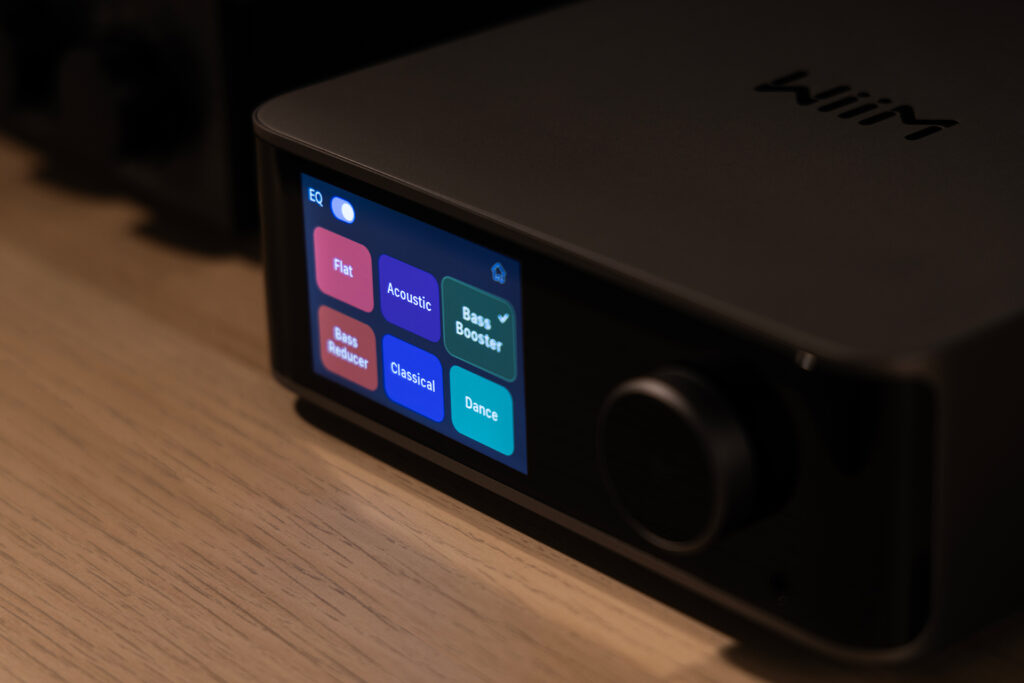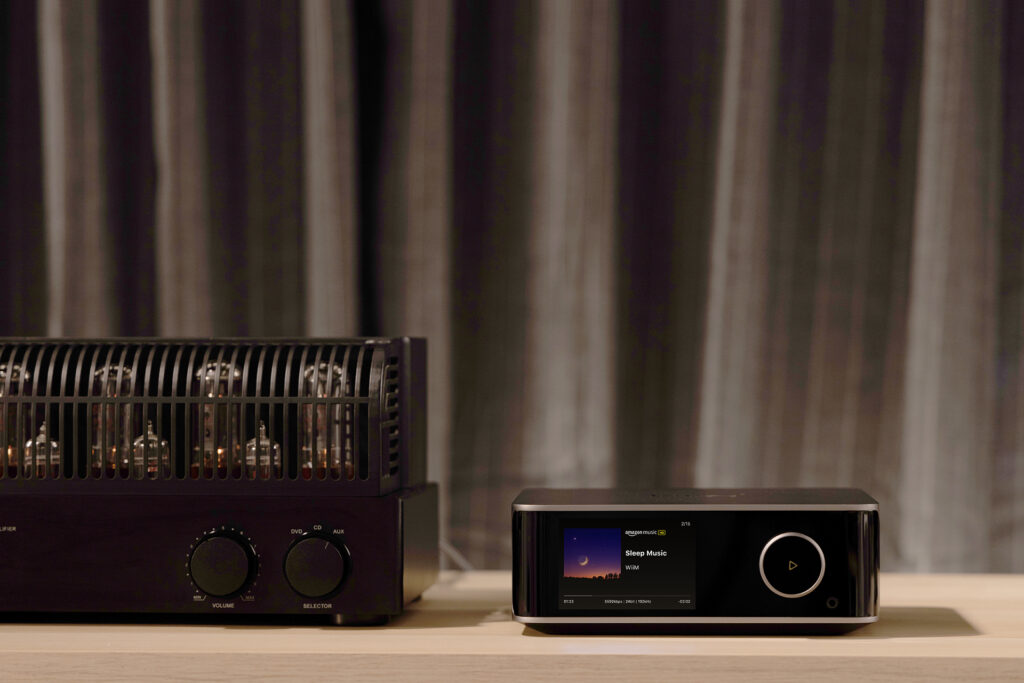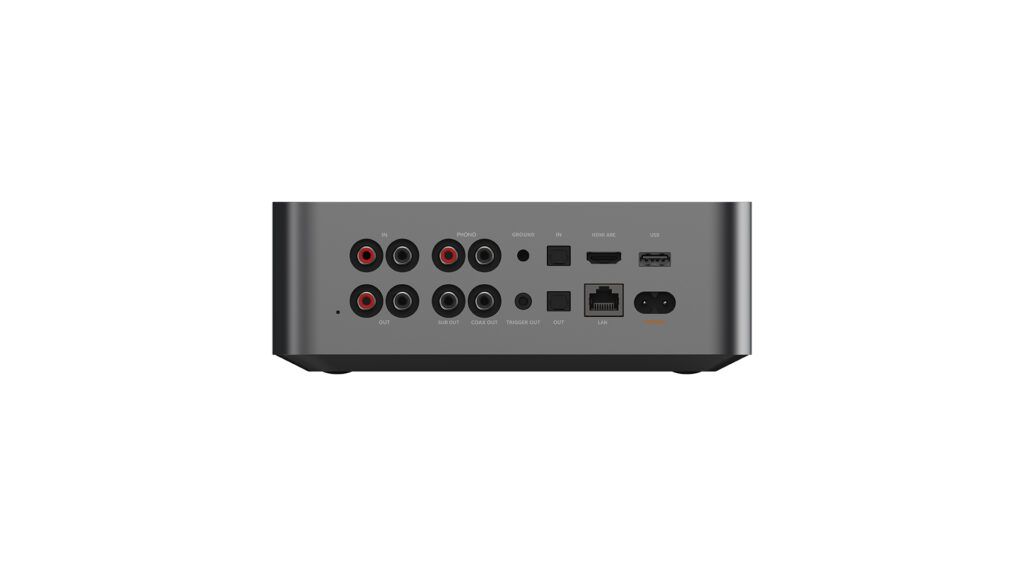WiiM, part of Linkplay Technology, which started in 2014 with experience in streaming audio software and hardware to major audio companies like Harman, JBL, Yamaha, to name a few, has for a few years developed its product line of streaming electronics to bring high technology in the streaming arena at astonishingly low prices. The WiiM Ultra is their top-tier, all-in-one network transport and DAC (digital to analog converter). A product like the WiiM Ultra connects to your preamplifier, surround sound receiver, and processor. Additionally, the WiiM Ultra has the additional functionality of a preamplifier that can directly connect to an amplifier, using the Ultra’s internal volume control. Upon receiving the WiiM Ultra, removing it from its Apple-esque packaging, and feeling its combination of aluminum and well-finished plastic enclosure, I immediately thought the product’s stature was well above its retail price of $329. It explains the vast coverage of WiiM’s Ultra all-in-one streamer DAC, which is highly regarded in print and online. Let’s explore what the Ultra has in its bag of tricks, and determine if all the hype is real.

What Makes the WiiM Ultra So Special?
- The WiiM Ultra has a mixture of aluminum and plastic casework with a good fit and finish, which is available in dark grey or silver.
- The 3.5-inch glass touchscreen display for extensive control and display of the cover art is a nice touch, and why I suspect this product has received so much attention (combined with its $329 price). Let’s face it: pretty and affordable don’t usually go hand in hand. The display is difficult to see from a standard seated position, but still exudes sophistication and quality, while creating pride of ownership for the end user.
- All WiiM streaming products, including the Ultra, benefit from its operating system and companion WiiM Home app, which has plenty of functionality and control and, in this case, can be seen from your seated position, since you will be holding your mobile device.
- The WiiM Ultra uses a single ESS Saber 9038Q2M stereo DAC, which is third in line from the top of their two-channel DAC products.
- The WiiM operating system supports Spotify Connect, TIDAL Connect, Google Cast Audio (CastLite), Alexa, DLNA, Squeezelite, and Roon-Ready certification. Plus, 19 of the most popular music streaming services (except Apple Music) are integrated into the WiiM Home app, including Spotify, Tidal, Qobuz, Amazon Music, and Pandora, to name a few.
- The WiiM Ultra has Wi-Fi 6E and Bluetooth 5.3 for wireless connectivity. Built-in antennas eliminate the need for peripheral items to attach to and protrude from the casework.
- The WiiM Ultra uses RCA coax analog outputs to connect with most preamplifiers, ensuring mass compatibility.
- Digital outputs include RCA coax, Toslink, and USB 2.0, so the Ultra can bypass its internal DAC when the time is right to expand your system.
- With its internal volume control, the WiiM Ultra can be used as a preamplifier with digital and analog inputs, which include HDMI ARC, Toslink, RCA line level, and phono.
- The Ultra includes a 3.5-millimeter headphone output powered by a Texas Instruments amplifier to power your favorite headphones.
- The WiiM Ultra Home app includes room correction software that works with your mobile device microphone. It is simple to use and may positively affect your room, although it did not do much for my situation.
- The WiiM app also includes a parametric equalizer, which can be configured separately for each input and channel. I experimented lightly with it, but I typically do not use equalization much in my situation. However, it is there if you feel you need it.
- The WiiM Ultra has five selectable line output levels, controlled through the WiiM app, a welcome feature allowing preamplifier matching for improved performance.
- A subwoofer output is a helpful feature with adjustable high- and low-frequency cutoff controllable from the WiiM Home app.
- The WiiM Ultra includes a Bluetooth remote control, but it is hardly needed, considering the WiiM Home app’s functionality.
Why Should You Care About the WiiM Ultra Streamer DAC?
The WiiM Ultra combines features and price uniquely, offering a high-value proposition that will attract younger customers or those on a tight budget, hopefully growing a new crop of audio enthusiasts. The WiiM Ultra dangles a taste of what is possible, and does so at an astonishingly low barrier to entry into the world of audiophilia. While on that path, the Ultra will provide years of enjoyment, fostering future audiophile consumers. If consumers end their journey with the Ultra, that is also fine, because it allows them to dabble in the high end, while not jeopardizing their financial standing.

Some Things You Might Not Like About the WiiM Ultra …
- I would be remiss if I did not mention that the WiiM Ultra does not work with Apple Airplay. However, I couldn’t care less about this omission, because Airplay has no place in a home system. While it may be okay to connect to your car audio system, Airplay is one of the worst ways to connect to your streamer and defeats a large part of your streamer’s purpose.
- Preamplifier functionality is not a strength for the WiiM Ultra – the online FAQ acknowledges this with the comment, “For best sound quality, use the Fixed volume selection,” and they were not kidding. Additionally, the volume control feel aligns with WiiM Ultra’s price point, which is inexpensive.
- The WiiM Ultra lacks an AES/EU digital output and XLR analog outputs.
- The WiiM Ultra does have an HDMI input, which can be helpful, but an HDMI output to display album art and track information on your big screen is a feature that I like, but it is not common in most streamers. However, I am beginning to see this feature on a few streamers.

Listening to the WiiM Ultra Audiophile Music Streamer …
My current reference system is a Pass Labs XP 22 preamplifier, wired to a set of Pass Labs XA60.8 high-current monoblock amplifiers, operating in full Class-A mode up to 60 watts at eight ohms, doubling power at four ohms, and again at two ohms.
The WiiM Ultra connected to my system by its analog RCA outputs to the preamplifier, and its digital SPDIF coax output to a PS Audio Stellar Gold DAC.
Estelon Aura floorstanding speakers would be the final stage of my system, creating a highly resolving platform.
The system benefits from Wireworld Eclipse 8 speaker cables, interconnects, and Electra 7 power cables for the amplifiers.
Fleetwood Mac’s “Gold Dust Woman” from their 1976 Rumours album, remastered in 2001, Tidal FLAC 96 kHz 24-bit, is one of many songs I ran through in my comparisons. The WiiM’s default is with the volume activated, so I would learn quickly that the preamplifier functionality of the Ultra is not its strength. It was clear that low-end bass extension and overall three-dimensionality of instruments were shy. Changing the volume to fixed improved overall clarity and depth. The soundstage was good, but lacking something. Imaging was enjoyable, but not the last word. Compared to a third-generation Bluesound Node, which I had on hand (fourth-generation recently released), toggling between two inputs on my preamplifier remote with the same track queued up, I could easily hear that the Node had an advantage. In some instances, the difference was slight, but in other areas, the Node was livelier and more convincing in a noticeable way.
Natalie Merchant’s “San Andreas Fault” from her 1995 Tigerlily album, Tidal FLAC 44.1 kHz 16-bit, displayed the same characteristics. Clarity was a notch better with the Bluesound Node, and there was better separation of instruments. The WiiM was good but seemed restricted and flat in comparison. However, it was still enjoyable.
To sort this out further, I connected the WiiM Ultra and the Bluesound Node’s digital coax outputs to an outboard PS Audio Stellar Gold DAC. Comparing the streamers in this way would accomplish two things. First, it would improve the DAC sophistication for both transports and allow a comparison of the transport portions of both devices. With the same tracks, the Ultra became closer in sound quality to the Node, but still not entirely equal. The Node’s robustness gleamed off a darker background, portraying more clarity. The distinction was not dramatic, but still apparent. The experiment suggests that the Node has an advantage in DAC implementation, and the transport side of the streamer DAC.
For fun, I added another transport, the PS Audio AirLens, which is at a significantly higher price point. To keep the comparison consistent and relevant, I used the same digital coax output type on the AirLens and, since there are only two coax digital inputs on the Stellar Gold DAC, the comparison required the elimination of one streamer. Using the King of the Hill philosophy, and since the Node prevailed, I kicked out the WiiM Ultra. Additionally, it was necessary to migrate both streamers to Roon, as that is the primary way to use the AirLens. With the same tracks, it was clear that the AirLens had a good advantage over the Node. A more effortless sound emanated from my speakers, with more separation from the background. Higher frequencies like cymbals floated and decayed naturally, eliminating any semblance and harshness we tend to accept. While this comparison may not seem relevant, since we are focusing on the WiiM Ultra, it shows that transports and DACs with improved design make a difference – in some cases.
To take it further, I replaced the PS Audio AirLens with the WiiM Ultra, allowing for a Bluesound Node and WiiM Ultra comparison within the Roon playground. The Node consistently displayed a sonic audio performance advantage with the same two tracks and many others. Again, it was not a night and day difference, but the Node consistently had the upper hand. However, given its price point, I appreciate everything the WiiM Ultra accomplishes.

Will the WiiM Ultra Audiophile Music Streamer Keep its Value?
The WiiM Ultra has an advantage, in that it does not have far to fall in price. But I would buy it, use it, and, when it’s time to upgrade, repurpose it to a different room or garage. The Ultra’s disadvantage is the same as that of any other all-in-one streamer: competition in this segment is hot, with manufacturers stepping up performance, features, and form factor at every new iteration. Additionally, DAC chip technology is evolving quickly, with new models and upgraded performance becoming available faster than manufacturers can implement them into their designs. This challenge exists for all integrators. Still, average depreciation will prevail, but only if you try to sell it.
What Is the Competition for the WiiM Ultra Music Streamer?
Bluesound is a great competitor to the WiiM products since these two brands have similar price points, a robust operating system and app, and the most music streaming service integrations of any operating systems I know. The third-generation Node used for comparison purposes during this review is still available as a 2021 model on the Bluesound website for $349. Of course, the newer Bluesound Node Nano (2024), which retails for $299 and uses a newer ESS Saber DAC with their latest HyperStream IV modulator, compared to the WiiM Ultra’s older DAC chipset, could be the better route. Another newer 2024 Bluesound model, a step up from the Nano, referred to as simply the Node ($549), has a few more features: a THX AAA headphone amplifier with an audiophile-approved one-quarter-inch headphone jack, and is Dirac Live-ready, which allows the user to purchase ($99 estimate) and add the room correction software if desired.
If you are more concerned about sound quality than svelte casework and touchscreen and don’t mind a DIY aesthetic, consider the Orchard Audio Pecan Pi or Pi+, $599 or $799, respectively.While the price point is substantially higher, these units have a true audiophile-centric philosophy, with specifications and measured performance graphs to back up their claims. Check out my review of these two stellar units to see if increasing your budget makes sense.

Final Thoughts on the WiiM Ultra Streamer …
The WiiM Ultra proved to be a reliable streaming DAC with a nice operating system and app functionality that I found easy to work with. The fit and finish are nice, and the touchscreen gives it beauty. Additionally, connectivity on the WiiM Ultra surpasses its price point. While I experienced slightly better audio performance from the Bluesound Node, it is important to recognize my system is highly revealing; if your system, particularly the speakers, is not as resolving, the difference may be negligible, especially if the WiiM is used for background music. With that said, if you are looking for a high-value streamer DAC that performs well and desire a pretty face with a sleek fit and finish, the WiiM Ultra should be a consideration.
Wiim Ultra Streamer FAQ
Is the WiiM Ultra Streamer better than Sonos?
For audiophiles, this is a likely yes.
For mainstream consumers, Sonos is pretty slick. BlueSound offers a close competitor to Sonos and WiiM.
Does WiiM have room correction?
No. Nor does Sonos.
As of January 2025, BlueSound offers Dirac which is one of the best DRCs (digital room correction) platforms. You need to spend like $250 for a license and a little more for a measurement mic but the performance improvement is game changing.
Do I need to use an amp with the WiiM Ultra Streamer?
Yes.
WiiM has other streamers with amps built-in however.
Is the WiiM Ultra a stereo preamp?
No.
It is a music streamer. You need a stereo preamp or integrated amp or AV receiver in most configurations.
Does the WiiM have USB digital outputs?
Yes.
We recommend that you use COAX instead as USB can be noisy for audiophile purposes.




It would have been a bit more illustrative if you had used USB as a connection to the external DAC so that the better clock in the external DAC was doing the “driving”. Then we would know a bit more about how good the WiiM Ultra is as a transport only. It is known that the clock in the WiiM is its weakest link. That the old Node bested it might be due to it having a better internal clock. At $330, it is definitely a good bargain for those getting into streaming. Also note that the “new” 2024 Node 132 is now $649, a $100 bump from the older Node, so yeah, at nearly double the cost of the WiiM Ultra, it had better be better.
I fully agree.with Warren.
I got three WiiM Ultras and I use them strictly as a bridge from WiFi/Ethernet to USB. Two are wired on my home LAN at GigE, the other one is on a dedicated WiFi access point in my home at 5Ghz.
The USBs are all quite good… and I’ve hooked them up via the USB.
Sources are Chromebooks, Android phones and a couple of PCs. All running Tidal HiFi via Tidal Connect. Before, I had the Chromebooks and Android connected via USB-OTG to the DACs but the data was not bit perfect as it was being reclocked.
With the WiiM Ultra in the middle, I can now see the bit rates in the DAC reflect exactly the bit rates that Tidal is playing. So, this is bit perfect, and I can hear the sound. I’m running the Ultra with fixed volume so there is no monkeying around with the received audio signal over WiFi….
I won’t describe my systems… let me tell ya I got a bunch of amps… and yes, Nelson’s designs… love that Class A FET and SIT sound!
Needless to say, for 350 bucks, I solved my bit perfect blues. And, yes, I can hear the difference. The treble and midrange are much clearer and the soundstage is almost, but not as good yet, as my Linn LP12 set up with one of Wayne’s phono preamps…. 😉
I think I will try the built in DAC in the home theater as a 2 channel analog input… but for the time being, I’m pretty happy.
So… as Warren said… USE THE USB connection to the DAC. Ignore the DAC and what not inside the WiiM Ultra. For that price, what do you expect.
Oh, user interface, still hit and miss. WiiM Home don’t work in Chromebook, half functional in Windows, fully functional with Android phone/tablet. I don’t do Apple.
Horrible customer service. I recently attempted to have them send me another power cord, because mine is shorted out, but they claimed they couldn’t send it, for some odd reason. ….avoid this crap.
Scott Walters
Tengo el reproductor de audio en red Yamaha NP-S303 y suena ligeramente mejor que el WIIM ULTRA. Lo he probado con parlantes FOCAL, DALI y ELAC.